A Detailed Case Study on Apple Company's Supply Chain Analysis
VerifiedAdded on 2023/06/11
|18
|4076
|123
Case Study
AI Summary
This case study provides a comprehensive analysis of Apple Inc.'s supply chain, examining its strategies, supplier relationships, and sustainability efforts. Apple's supply chain relies on a vast network of third-party distributors, with a significant portion based in China. The company employs a multiple-supplier approach to mitigate risks and maintain gross margins, enabling it to adjust ordering ratios and respond to fluctuations in consumer demand. Despite its successes, the analysis reveals flaws, including performance issues, margin frays among suppliers, and sustainability concerns such as labor and environmental desecrations. The study also highlights the importance of end-to-end supply chain visibility and the potential for improved profitability through optimized sourcing and manufacturing procedures. The document emphasizes that Desklib offers similar case studies and solved assignments for students.
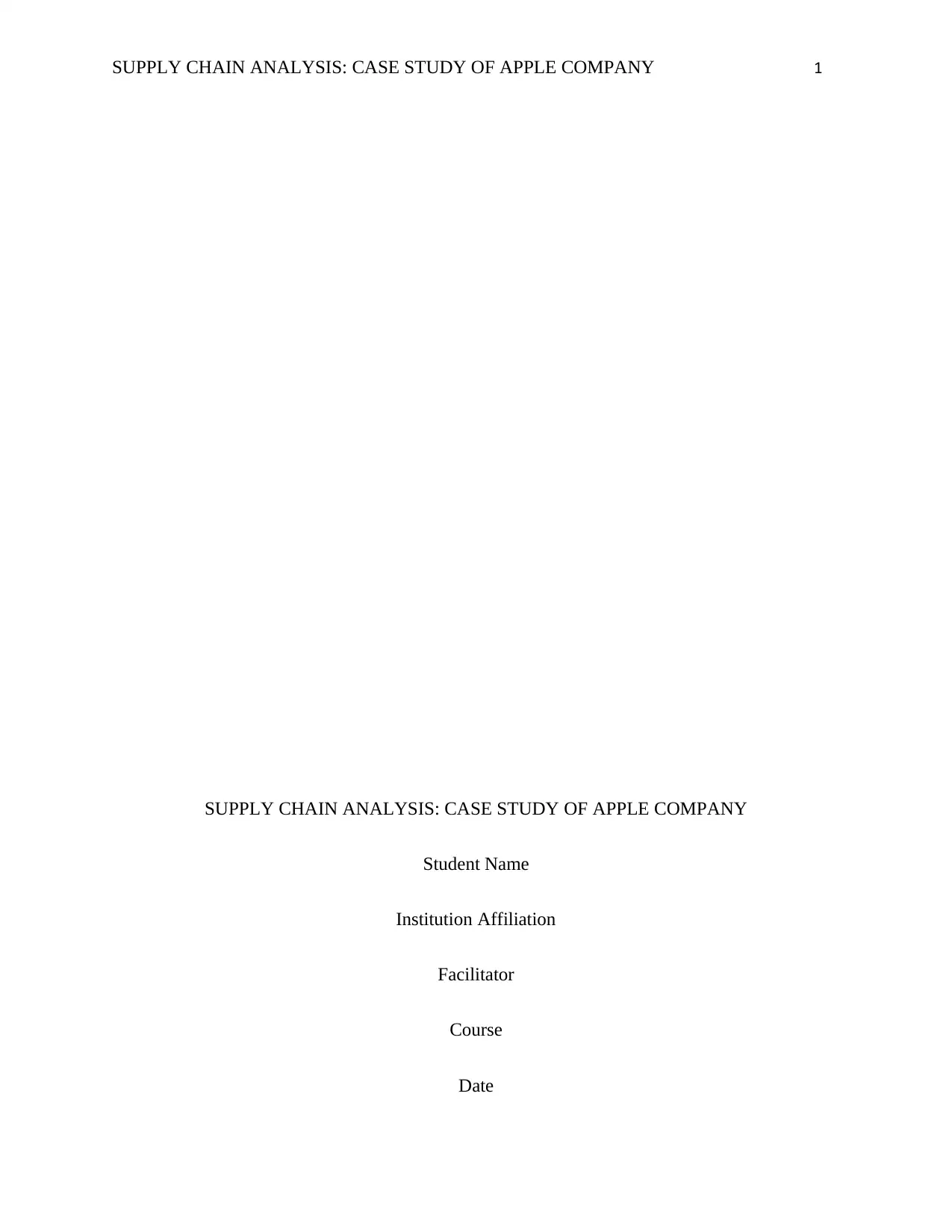
SUPPLY CHAIN ANALYSIS: CASE STUDY OF APPLE COMPANY 1
SUPPLY CHAIN ANALYSIS: CASE STUDY OF APPLE COMPANY
Student Name
Institution Affiliation
Facilitator
Course
Date
SUPPLY CHAIN ANALYSIS: CASE STUDY OF APPLE COMPANY
Student Name
Institution Affiliation
Facilitator
Course
Date
Paraphrase This Document
Need a fresh take? Get an instant paraphrase of this document with our AI Paraphraser
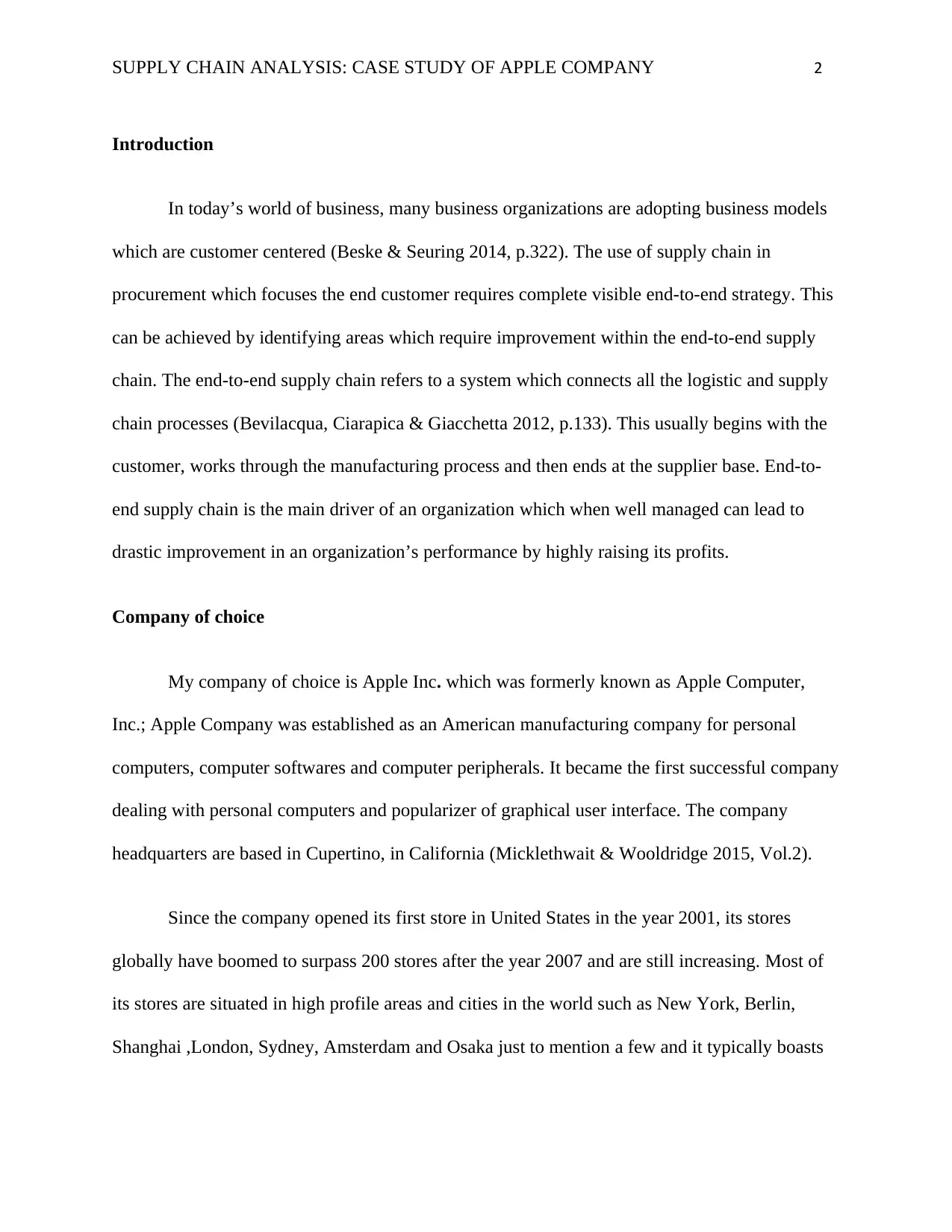
SUPPLY CHAIN ANALYSIS: CASE STUDY OF APPLE COMPANY 2
Introduction
In today’s world of business, many business organizations are adopting business models
which are customer centered (Beske & Seuring 2014, p.322). The use of supply chain in
procurement which focuses the end customer requires complete visible end-to-end strategy. This
can be achieved by identifying areas which require improvement within the end-to-end supply
chain. The end-to-end supply chain refers to a system which connects all the logistic and supply
chain processes (Bevilacqua, Ciarapica & Giacchetta 2012, p.133). This usually begins with the
customer, works through the manufacturing process and then ends at the supplier base. End-to-
end supply chain is the main driver of an organization which when well managed can lead to
drastic improvement in an organization’s performance by highly raising its profits.
Company of choice
My company of choice is Apple Inc. which was formerly known as Apple Computer,
Inc.; Apple Company was established as an American manufacturing company for personal
computers, computer softwares and computer peripherals. It became the first successful company
dealing with personal computers and popularizer of graphical user interface. The company
headquarters are based in Cupertino, in California (Micklethwait & Wooldridge 2015, Vol.2).
Since the company opened its first store in United States in the year 2001, its stores
globally have boomed to surpass 200 stores after the year 2007 and are still increasing. Most of
its stores are situated in high profile areas and cities in the world such as New York, Berlin,
Shanghai ,London, Sydney, Amsterdam and Osaka just to mention a few and it typically boasts
Introduction
In today’s world of business, many business organizations are adopting business models
which are customer centered (Beske & Seuring 2014, p.322). The use of supply chain in
procurement which focuses the end customer requires complete visible end-to-end strategy. This
can be achieved by identifying areas which require improvement within the end-to-end supply
chain. The end-to-end supply chain refers to a system which connects all the logistic and supply
chain processes (Bevilacqua, Ciarapica & Giacchetta 2012, p.133). This usually begins with the
customer, works through the manufacturing process and then ends at the supplier base. End-to-
end supply chain is the main driver of an organization which when well managed can lead to
drastic improvement in an organization’s performance by highly raising its profits.
Company of choice
My company of choice is Apple Inc. which was formerly known as Apple Computer,
Inc.; Apple Company was established as an American manufacturing company for personal
computers, computer softwares and computer peripherals. It became the first successful company
dealing with personal computers and popularizer of graphical user interface. The company
headquarters are based in Cupertino, in California (Micklethwait & Wooldridge 2015, Vol.2).
Since the company opened its first store in United States in the year 2001, its stores
globally have boomed to surpass 200 stores after the year 2007 and are still increasing. Most of
its stores are situated in high profile areas and cities in the world such as New York, Berlin,
Shanghai ,London, Sydney, Amsterdam and Osaka just to mention a few and it typically boasts
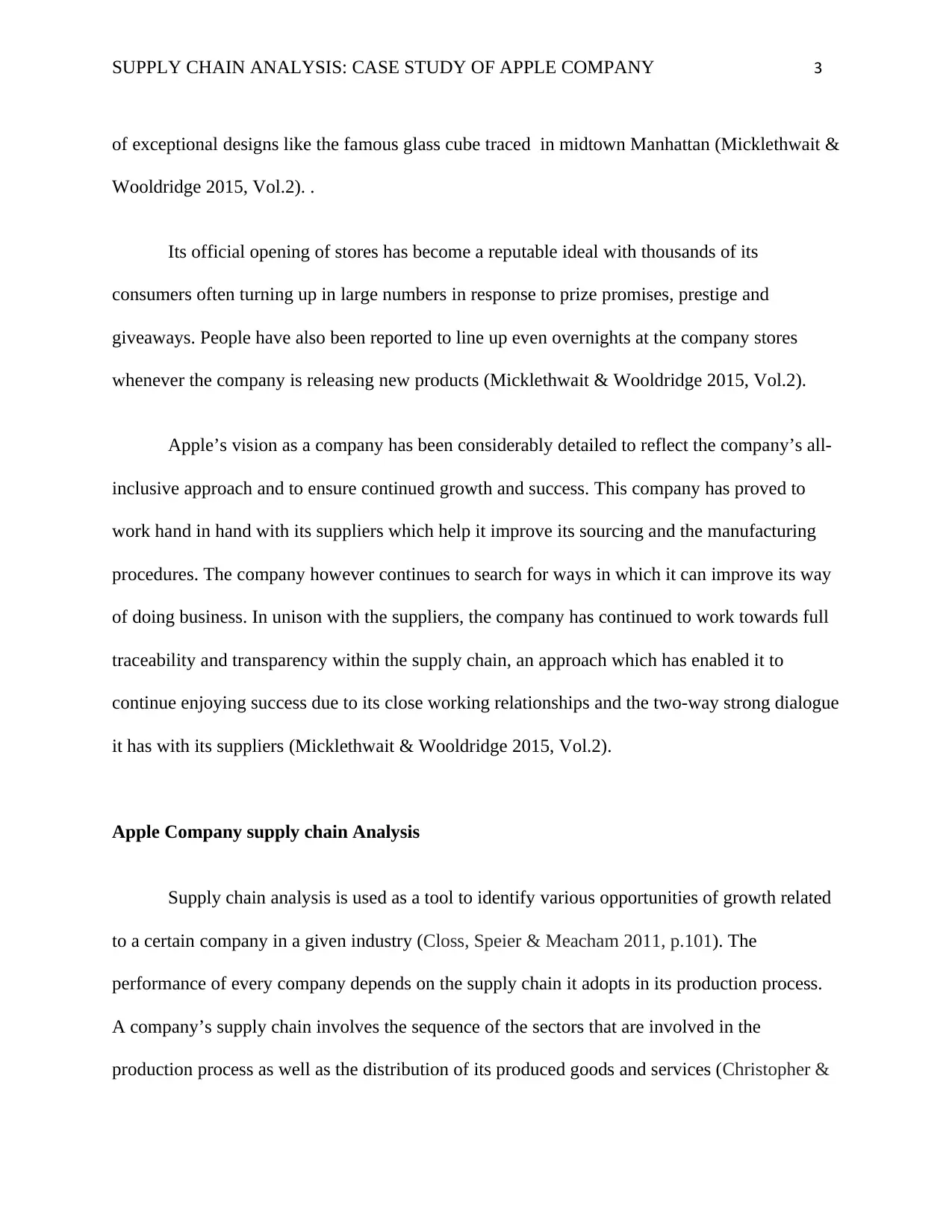
SUPPLY CHAIN ANALYSIS: CASE STUDY OF APPLE COMPANY 3
of exceptional designs like the famous glass cube traced in midtown Manhattan (Micklethwait &
Wooldridge 2015, Vol.2). .
Its official opening of stores has become a reputable ideal with thousands of its
consumers often turning up in large numbers in response to prize promises, prestige and
giveaways. People have also been reported to line up even overnights at the company stores
whenever the company is releasing new products (Micklethwait & Wooldridge 2015, Vol.2).
Apple’s vision as a company has been considerably detailed to reflect the company’s all-
inclusive approach and to ensure continued growth and success. This company has proved to
work hand in hand with its suppliers which help it improve its sourcing and the manufacturing
procedures. The company however continues to search for ways in which it can improve its way
of doing business. In unison with the suppliers, the company has continued to work towards full
traceability and transparency within the supply chain, an approach which has enabled it to
continue enjoying success due to its close working relationships and the two-way strong dialogue
it has with its suppliers (Micklethwait & Wooldridge 2015, Vol.2).
Apple Company supply chain Analysis
Supply chain analysis is used as a tool to identify various opportunities of growth related
to a certain company in a given industry (Closs, Speier & Meacham 2011, p.101). The
performance of every company depends on the supply chain it adopts in its production process.
A company’s supply chain involves the sequence of the sectors that are involved in the
production process as well as the distribution of its produced goods and services (Christopher &
of exceptional designs like the famous glass cube traced in midtown Manhattan (Micklethwait &
Wooldridge 2015, Vol.2). .
Its official opening of stores has become a reputable ideal with thousands of its
consumers often turning up in large numbers in response to prize promises, prestige and
giveaways. People have also been reported to line up even overnights at the company stores
whenever the company is releasing new products (Micklethwait & Wooldridge 2015, Vol.2).
Apple’s vision as a company has been considerably detailed to reflect the company’s all-
inclusive approach and to ensure continued growth and success. This company has proved to
work hand in hand with its suppliers which help it improve its sourcing and the manufacturing
procedures. The company however continues to search for ways in which it can improve its way
of doing business. In unison with the suppliers, the company has continued to work towards full
traceability and transparency within the supply chain, an approach which has enabled it to
continue enjoying success due to its close working relationships and the two-way strong dialogue
it has with its suppliers (Micklethwait & Wooldridge 2015, Vol.2).
Apple Company supply chain Analysis
Supply chain analysis is used as a tool to identify various opportunities of growth related
to a certain company in a given industry (Closs, Speier & Meacham 2011, p.101). The
performance of every company depends on the supply chain it adopts in its production process.
A company’s supply chain involves the sequence of the sectors that are involved in the
production process as well as the distribution of its produced goods and services (Christopher &
⊘ This is a preview!⊘
Do you want full access?
Subscribe today to unlock all pages.

Trusted by 1+ million students worldwide
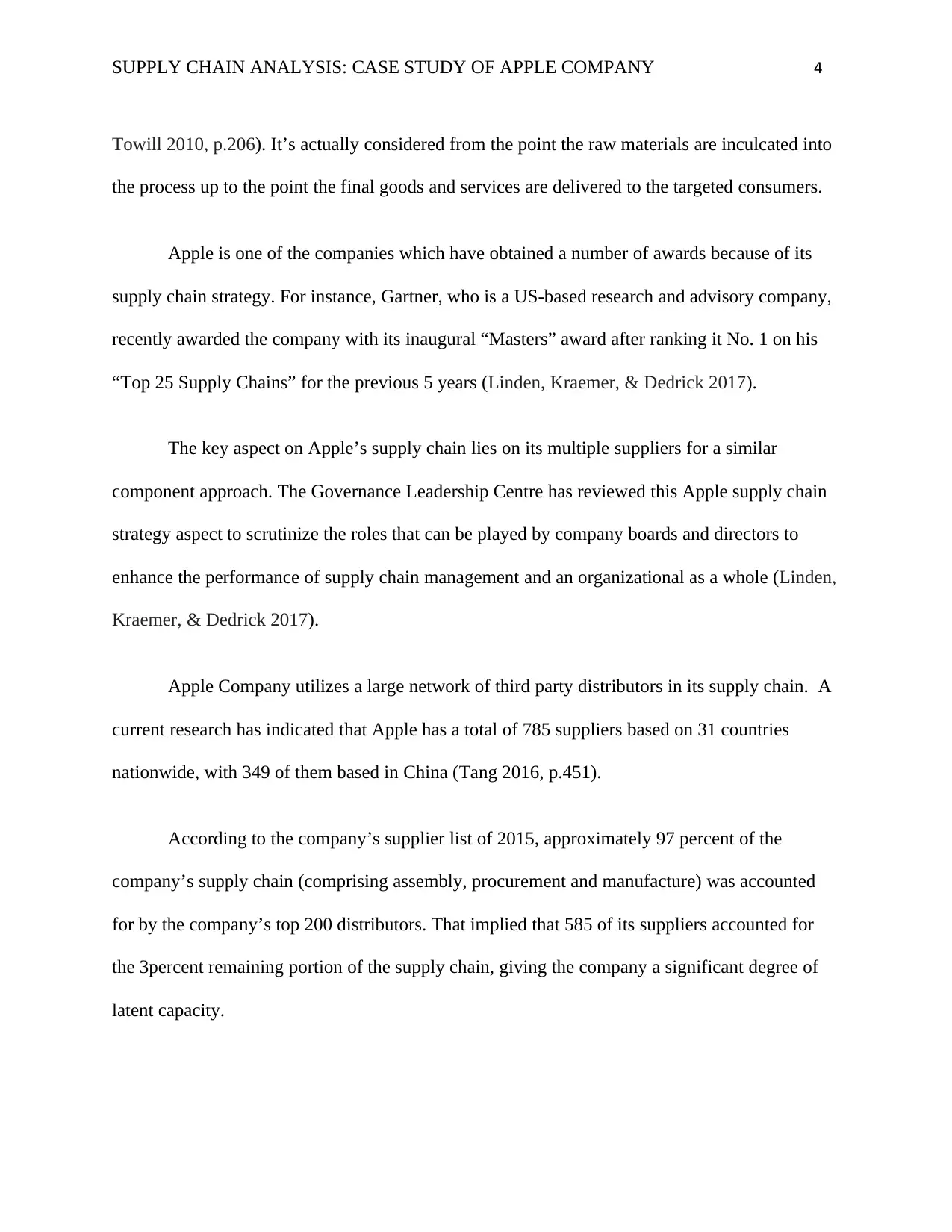
SUPPLY CHAIN ANALYSIS: CASE STUDY OF APPLE COMPANY 4
Towill 2010, p.206). It’s actually considered from the point the raw materials are inculcated into
the process up to the point the final goods and services are delivered to the targeted consumers.
Apple is one of the companies which have obtained a number of awards because of its
supply chain strategy. For instance, Gartner, who is a US-based research and advisory company,
recently awarded the company with its inaugural “Masters” award after ranking it No. 1 on his
“Top 25 Supply Chains” for the previous 5 years (Linden, Kraemer, & Dedrick 2017).
The key aspect on Apple’s supply chain lies on its multiple suppliers for a similar
component approach. The Governance Leadership Centre has reviewed this Apple supply chain
strategy aspect to scrutinize the roles that can be played by company boards and directors to
enhance the performance of supply chain management and an organizational as a whole (Linden,
Kraemer, & Dedrick 2017).
Apple Company utilizes a large network of third party distributors in its supply chain. A
current research has indicated that Apple has a total of 785 suppliers based on 31 countries
nationwide, with 349 of them based in China (Tang 2016, p.451).
According to the company’s supplier list of 2015, approximately 97 percent of the
company’s supply chain (comprising assembly, procurement and manufacture) was accounted
for by the company’s top 200 distributors. That implied that 585 of its suppliers accounted for
the 3percent remaining portion of the supply chain, giving the company a significant degree of
latent capacity.
Towill 2010, p.206). It’s actually considered from the point the raw materials are inculcated into
the process up to the point the final goods and services are delivered to the targeted consumers.
Apple is one of the companies which have obtained a number of awards because of its
supply chain strategy. For instance, Gartner, who is a US-based research and advisory company,
recently awarded the company with its inaugural “Masters” award after ranking it No. 1 on his
“Top 25 Supply Chains” for the previous 5 years (Linden, Kraemer, & Dedrick 2017).
The key aspect on Apple’s supply chain lies on its multiple suppliers for a similar
component approach. The Governance Leadership Centre has reviewed this Apple supply chain
strategy aspect to scrutinize the roles that can be played by company boards and directors to
enhance the performance of supply chain management and an organizational as a whole (Linden,
Kraemer, & Dedrick 2017).
Apple Company utilizes a large network of third party distributors in its supply chain. A
current research has indicated that Apple has a total of 785 suppliers based on 31 countries
nationwide, with 349 of them based in China (Tang 2016, p.451).
According to the company’s supplier list of 2015, approximately 97 percent of the
company’s supply chain (comprising assembly, procurement and manufacture) was accounted
for by the company’s top 200 distributors. That implied that 585 of its suppliers accounted for
the 3percent remaining portion of the supply chain, giving the company a significant degree of
latent capacity.
Paraphrase This Document
Need a fresh take? Get an instant paraphrase of this document with our AI Paraphraser
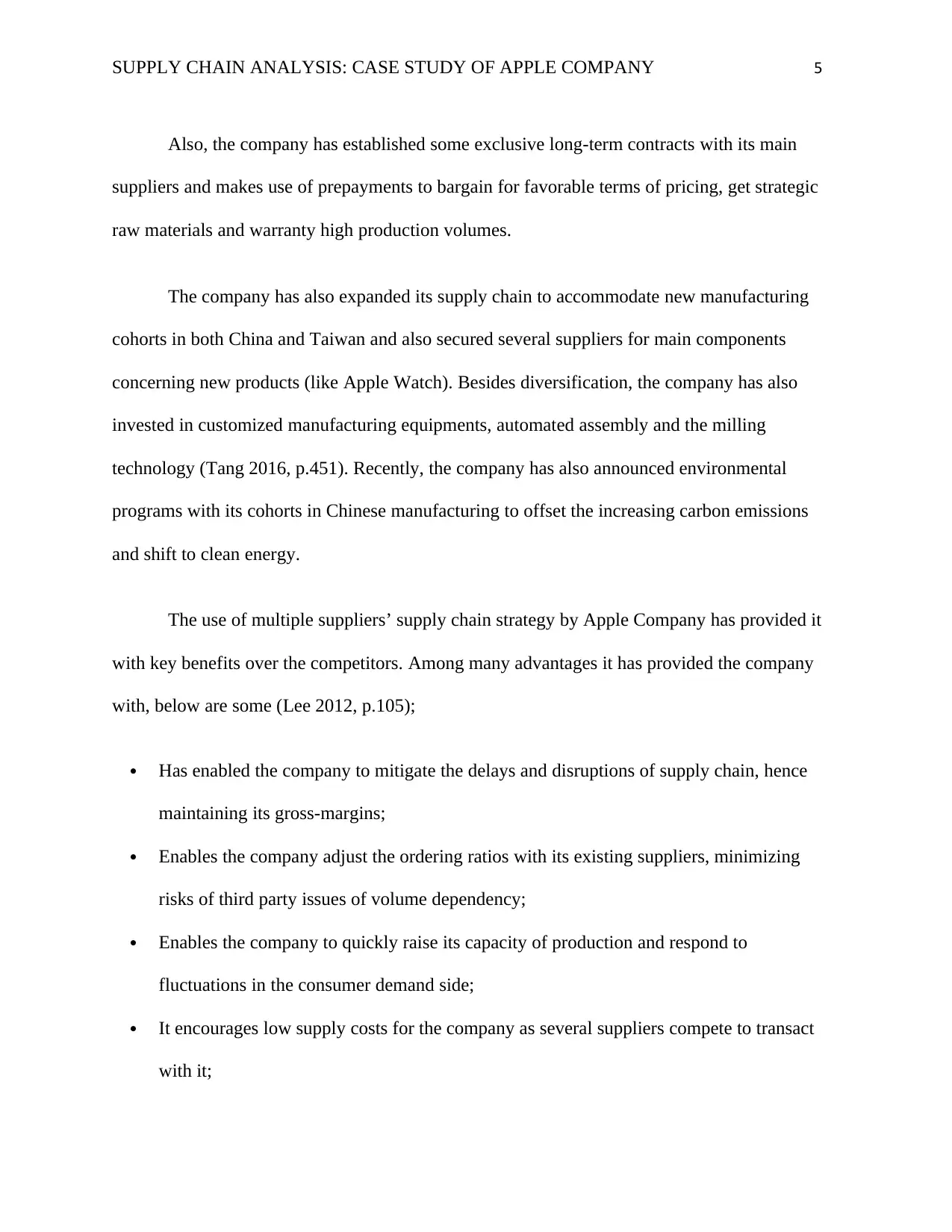
SUPPLY CHAIN ANALYSIS: CASE STUDY OF APPLE COMPANY 5
Also, the company has established some exclusive long-term contracts with its main
suppliers and makes use of prepayments to bargain for favorable terms of pricing, get strategic
raw materials and warranty high production volumes.
The company has also expanded its supply chain to accommodate new manufacturing
cohorts in both China and Taiwan and also secured several suppliers for main components
concerning new products (like Apple Watch). Besides diversification, the company has also
invested in customized manufacturing equipments, automated assembly and the milling
technology (Tang 2016, p.451). Recently, the company has also announced environmental
programs with its cohorts in Chinese manufacturing to offset the increasing carbon emissions
and shift to clean energy.
The use of multiple suppliers’ supply chain strategy by Apple Company has provided it
with key benefits over the competitors. Among many advantages it has provided the company
with, below are some (Lee 2012, p.105);
Has enabled the company to mitigate the delays and disruptions of supply chain, hence
maintaining its gross-margins;
Enables the company adjust the ordering ratios with its existing suppliers, minimizing
risks of third party issues of volume dependency;
Enables the company to quickly raise its capacity of production and respond to
fluctuations in the consumer demand side;
It encourages low supply costs for the company as several suppliers compete to transact
with it;
Also, the company has established some exclusive long-term contracts with its main
suppliers and makes use of prepayments to bargain for favorable terms of pricing, get strategic
raw materials and warranty high production volumes.
The company has also expanded its supply chain to accommodate new manufacturing
cohorts in both China and Taiwan and also secured several suppliers for main components
concerning new products (like Apple Watch). Besides diversification, the company has also
invested in customized manufacturing equipments, automated assembly and the milling
technology (Tang 2016, p.451). Recently, the company has also announced environmental
programs with its cohorts in Chinese manufacturing to offset the increasing carbon emissions
and shift to clean energy.
The use of multiple suppliers’ supply chain strategy by Apple Company has provided it
with key benefits over the competitors. Among many advantages it has provided the company
with, below are some (Lee 2012, p.105);
Has enabled the company to mitigate the delays and disruptions of supply chain, hence
maintaining its gross-margins;
Enables the company adjust the ordering ratios with its existing suppliers, minimizing
risks of third party issues of volume dependency;
Enables the company to quickly raise its capacity of production and respond to
fluctuations in the consumer demand side;
It encourages low supply costs for the company as several suppliers compete to transact
with it;
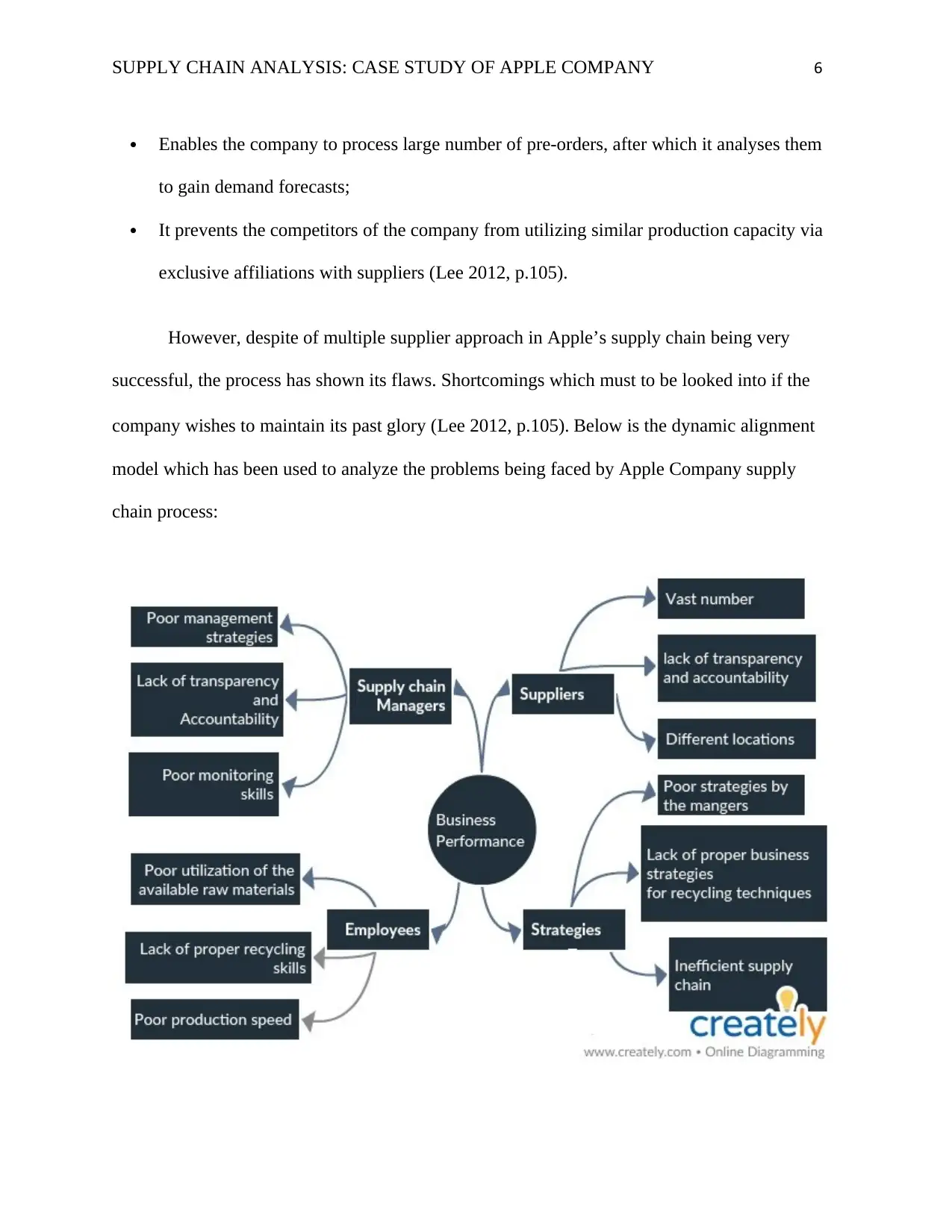
SUPPLY CHAIN ANALYSIS: CASE STUDY OF APPLE COMPANY 6
Enables the company to process large number of pre-orders, after which it analyses them
to gain demand forecasts;
It prevents the competitors of the company from utilizing similar production capacity via
exclusive affiliations with suppliers (Lee 2012, p.105).
However, despite of multiple supplier approach in Apple’s supply chain being very
successful, the process has shown its flaws. Shortcomings which must to be looked into if the
company wishes to maintain its past glory (Lee 2012, p.105). Below is the dynamic alignment
model which has been used to analyze the problems being faced by Apple Company supply
chain process:
Enables the company to process large number of pre-orders, after which it analyses them
to gain demand forecasts;
It prevents the competitors of the company from utilizing similar production capacity via
exclusive affiliations with suppliers (Lee 2012, p.105).
However, despite of multiple supplier approach in Apple’s supply chain being very
successful, the process has shown its flaws. Shortcomings which must to be looked into if the
company wishes to maintain its past glory (Lee 2012, p.105). Below is the dynamic alignment
model which has been used to analyze the problems being faced by Apple Company supply
chain process:
⊘ This is a preview!⊘
Do you want full access?
Subscribe today to unlock all pages.

Trusted by 1+ million students worldwide
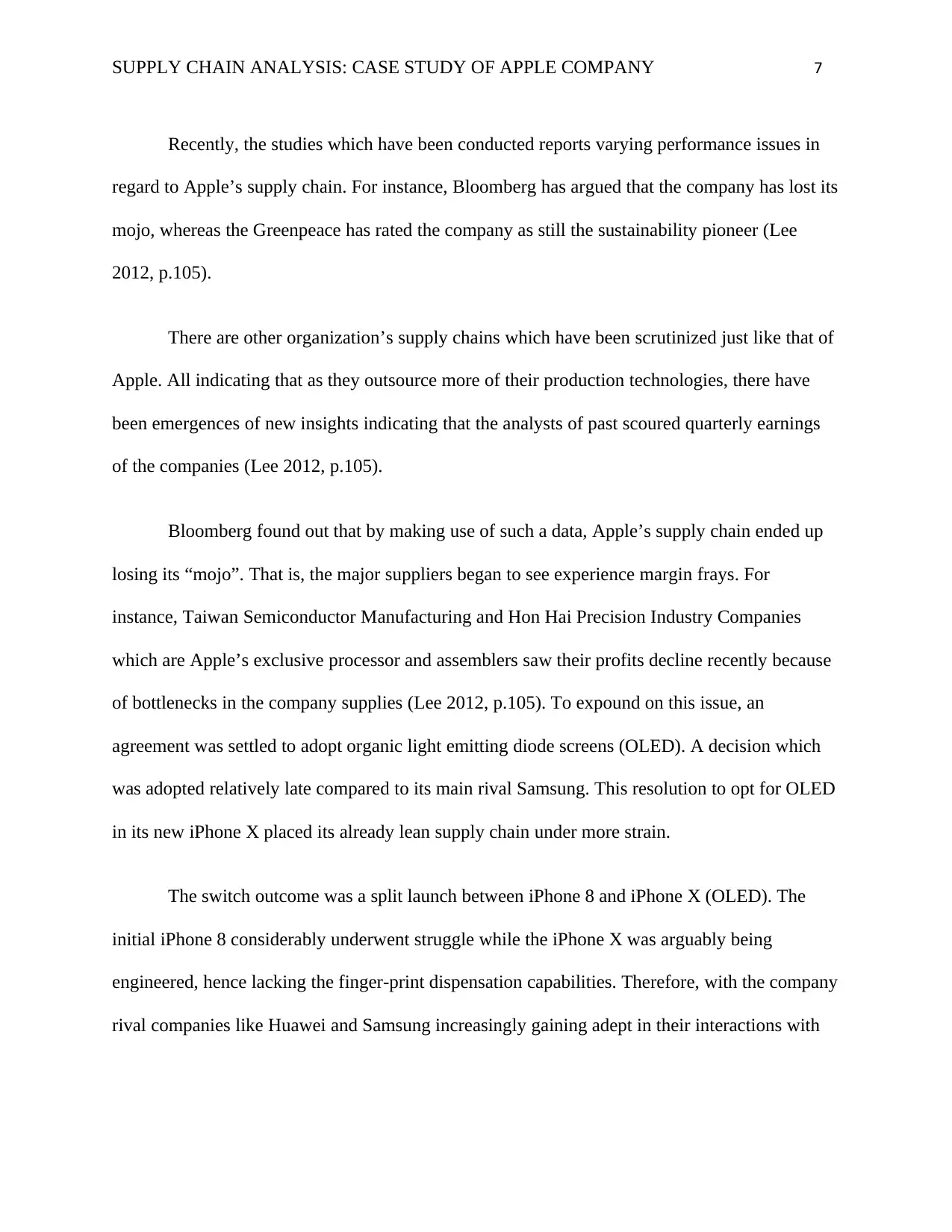
SUPPLY CHAIN ANALYSIS: CASE STUDY OF APPLE COMPANY 7
Recently, the studies which have been conducted reports varying performance issues in
regard to Apple’s supply chain. For instance, Bloomberg has argued that the company has lost its
mojo, whereas the Greenpeace has rated the company as still the sustainability pioneer (Lee
2012, p.105).
There are other organization’s supply chains which have been scrutinized just like that of
Apple. All indicating that as they outsource more of their production technologies, there have
been emergences of new insights indicating that the analysts of past scoured quarterly earnings
of the companies (Lee 2012, p.105).
Bloomberg found out that by making use of such a data, Apple’s supply chain ended up
losing its “mojo”. That is, the major suppliers began to see experience margin frays. For
instance, Taiwan Semiconductor Manufacturing and Hon Hai Precision Industry Companies
which are Apple’s exclusive processor and assemblers saw their profits decline recently because
of bottlenecks in the company supplies (Lee 2012, p.105). To expound on this issue, an
agreement was settled to adopt organic light emitting diode screens (OLED). A decision which
was adopted relatively late compared to its main rival Samsung. This resolution to opt for OLED
in its new iPhone X placed its already lean supply chain under more strain.
The switch outcome was a split launch between iPhone 8 and iPhone X (OLED). The
initial iPhone 8 considerably underwent struggle while the iPhone X was arguably being
engineered, hence lacking the finger-print dispensation capabilities. Therefore, with the company
rival companies like Huawei and Samsung increasingly gaining adept in their interactions with
Recently, the studies which have been conducted reports varying performance issues in
regard to Apple’s supply chain. For instance, Bloomberg has argued that the company has lost its
mojo, whereas the Greenpeace has rated the company as still the sustainability pioneer (Lee
2012, p.105).
There are other organization’s supply chains which have been scrutinized just like that of
Apple. All indicating that as they outsource more of their production technologies, there have
been emergences of new insights indicating that the analysts of past scoured quarterly earnings
of the companies (Lee 2012, p.105).
Bloomberg found out that by making use of such a data, Apple’s supply chain ended up
losing its “mojo”. That is, the major suppliers began to see experience margin frays. For
instance, Taiwan Semiconductor Manufacturing and Hon Hai Precision Industry Companies
which are Apple’s exclusive processor and assemblers saw their profits decline recently because
of bottlenecks in the company supplies (Lee 2012, p.105). To expound on this issue, an
agreement was settled to adopt organic light emitting diode screens (OLED). A decision which
was adopted relatively late compared to its main rival Samsung. This resolution to opt for OLED
in its new iPhone X placed its already lean supply chain under more strain.
The switch outcome was a split launch between iPhone 8 and iPhone X (OLED). The
initial iPhone 8 considerably underwent struggle while the iPhone X was arguably being
engineered, hence lacking the finger-print dispensation capabilities. Therefore, with the company
rival companies like Huawei and Samsung increasingly gaining adept in their interactions with
Paraphrase This Document
Need a fresh take? Get an instant paraphrase of this document with our AI Paraphraser
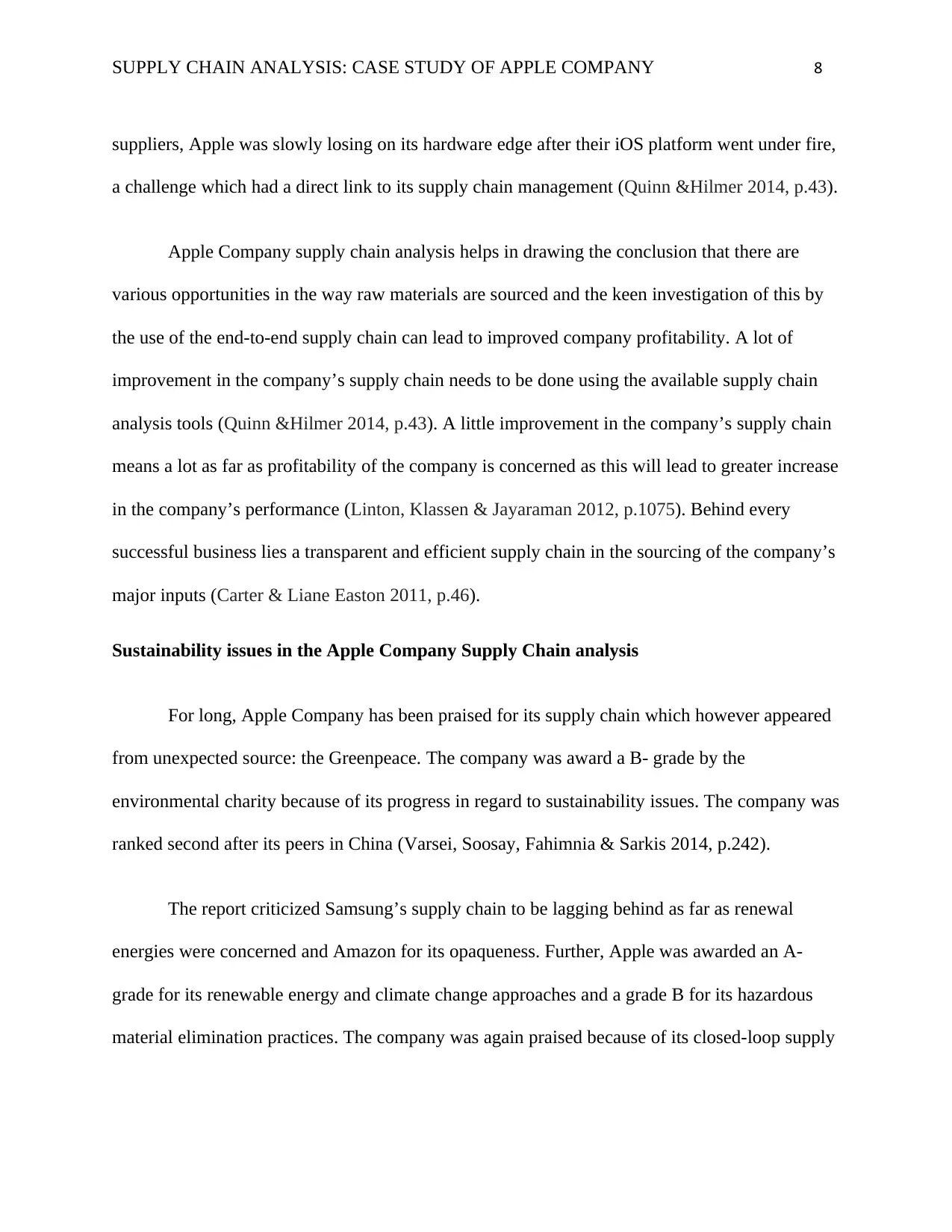
SUPPLY CHAIN ANALYSIS: CASE STUDY OF APPLE COMPANY 8
suppliers, Apple was slowly losing on its hardware edge after their iOS platform went under fire,
a challenge which had a direct link to its supply chain management (Quinn &Hilmer 2014, p.43).
Apple Company supply chain analysis helps in drawing the conclusion that there are
various opportunities in the way raw materials are sourced and the keen investigation of this by
the use of the end-to-end supply chain can lead to improved company profitability. A lot of
improvement in the company’s supply chain needs to be done using the available supply chain
analysis tools (Quinn &Hilmer 2014, p.43). A little improvement in the company’s supply chain
means a lot as far as profitability of the company is concerned as this will lead to greater increase
in the company’s performance (Linton, Klassen & Jayaraman 2012, p.1075). Behind every
successful business lies a transparent and efficient supply chain in the sourcing of the company’s
major inputs (Carter & Liane Easton 2011, p.46).
Sustainability issues in the Apple Company Supply Chain analysis
For long, Apple Company has been praised for its supply chain which however appeared
from unexpected source: the Greenpeace. The company was award a B- grade by the
environmental charity because of its progress in regard to sustainability issues. The company was
ranked second after its peers in China (Varsei, Soosay, Fahimnia & Sarkis 2014, p.242).
The report criticized Samsung’s supply chain to be lagging behind as far as renewal
energies were concerned and Amazon for its opaqueness. Further, Apple was awarded an A-
grade for its renewable energy and climate change approaches and a grade B for its hazardous
material elimination practices. The company was again praised because of its closed-loop supply
suppliers, Apple was slowly losing on its hardware edge after their iOS platform went under fire,
a challenge which had a direct link to its supply chain management (Quinn &Hilmer 2014, p.43).
Apple Company supply chain analysis helps in drawing the conclusion that there are
various opportunities in the way raw materials are sourced and the keen investigation of this by
the use of the end-to-end supply chain can lead to improved company profitability. A lot of
improvement in the company’s supply chain needs to be done using the available supply chain
analysis tools (Quinn &Hilmer 2014, p.43). A little improvement in the company’s supply chain
means a lot as far as profitability of the company is concerned as this will lead to greater increase
in the company’s performance (Linton, Klassen & Jayaraman 2012, p.1075). Behind every
successful business lies a transparent and efficient supply chain in the sourcing of the company’s
major inputs (Carter & Liane Easton 2011, p.46).
Sustainability issues in the Apple Company Supply Chain analysis
For long, Apple Company has been praised for its supply chain which however appeared
from unexpected source: the Greenpeace. The company was award a B- grade by the
environmental charity because of its progress in regard to sustainability issues. The company was
ranked second after its peers in China (Varsei, Soosay, Fahimnia & Sarkis 2014, p.242).
The report criticized Samsung’s supply chain to be lagging behind as far as renewal
energies were concerned and Amazon for its opaqueness. Further, Apple was awarded an A-
grade for its renewable energy and climate change approaches and a grade B for its hazardous
material elimination practices. The company was again praised because of its closed-loop supply
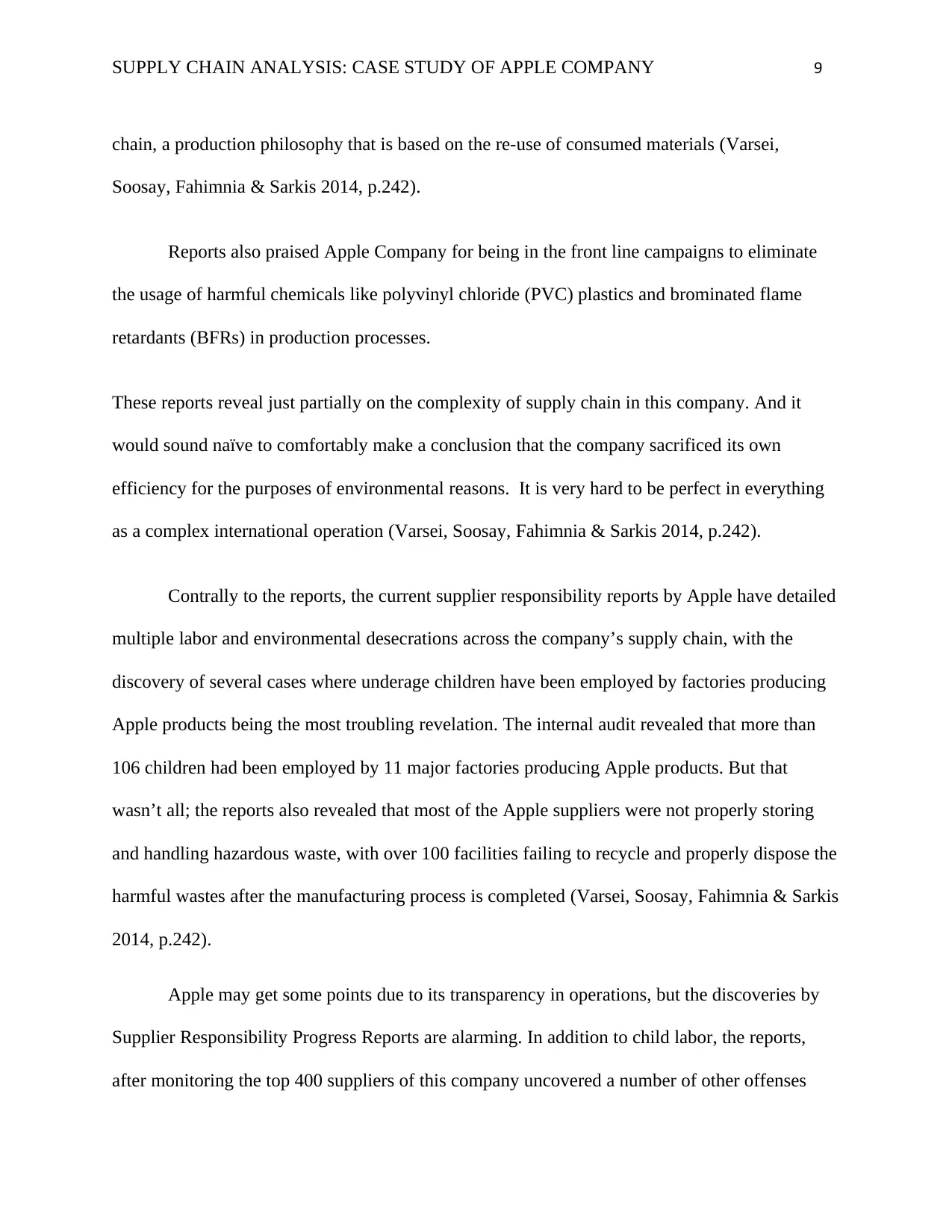
SUPPLY CHAIN ANALYSIS: CASE STUDY OF APPLE COMPANY 9
chain, a production philosophy that is based on the re-use of consumed materials (Varsei,
Soosay, Fahimnia & Sarkis 2014, p.242).
Reports also praised Apple Company for being in the front line campaigns to eliminate
the usage of harmful chemicals like polyvinyl chloride (PVC) plastics and brominated flame
retardants (BFRs) in production processes.
These reports reveal just partially on the complexity of supply chain in this company. And it
would sound naïve to comfortably make a conclusion that the company sacrificed its own
efficiency for the purposes of environmental reasons. It is very hard to be perfect in everything
as a complex international operation (Varsei, Soosay, Fahimnia & Sarkis 2014, p.242).
Contrally to the reports, the current supplier responsibility reports by Apple have detailed
multiple labor and environmental desecrations across the company’s supply chain, with the
discovery of several cases where underage children have been employed by factories producing
Apple products being the most troubling revelation. The internal audit revealed that more than
106 children had been employed by 11 major factories producing Apple products. But that
wasn’t all; the reports also revealed that most of the Apple suppliers were not properly storing
and handling hazardous waste, with over 100 facilities failing to recycle and properly dispose the
harmful wastes after the manufacturing process is completed (Varsei, Soosay, Fahimnia & Sarkis
2014, p.242).
Apple may get some points due to its transparency in operations, but the discoveries by
Supplier Responsibility Progress Reports are alarming. In addition to child labor, the reports,
after monitoring the top 400 suppliers of this company uncovered a number of other offenses
chain, a production philosophy that is based on the re-use of consumed materials (Varsei,
Soosay, Fahimnia & Sarkis 2014, p.242).
Reports also praised Apple Company for being in the front line campaigns to eliminate
the usage of harmful chemicals like polyvinyl chloride (PVC) plastics and brominated flame
retardants (BFRs) in production processes.
These reports reveal just partially on the complexity of supply chain in this company. And it
would sound naïve to comfortably make a conclusion that the company sacrificed its own
efficiency for the purposes of environmental reasons. It is very hard to be perfect in everything
as a complex international operation (Varsei, Soosay, Fahimnia & Sarkis 2014, p.242).
Contrally to the reports, the current supplier responsibility reports by Apple have detailed
multiple labor and environmental desecrations across the company’s supply chain, with the
discovery of several cases where underage children have been employed by factories producing
Apple products being the most troubling revelation. The internal audit revealed that more than
106 children had been employed by 11 major factories producing Apple products. But that
wasn’t all; the reports also revealed that most of the Apple suppliers were not properly storing
and handling hazardous waste, with over 100 facilities failing to recycle and properly dispose the
harmful wastes after the manufacturing process is completed (Varsei, Soosay, Fahimnia & Sarkis
2014, p.242).
Apple may get some points due to its transparency in operations, but the discoveries by
Supplier Responsibility Progress Reports are alarming. In addition to child labor, the reports,
after monitoring the top 400 suppliers of this company uncovered a number of other offenses
⊘ This is a preview!⊘
Do you want full access?
Subscribe today to unlock all pages.

Trusted by 1+ million students worldwide
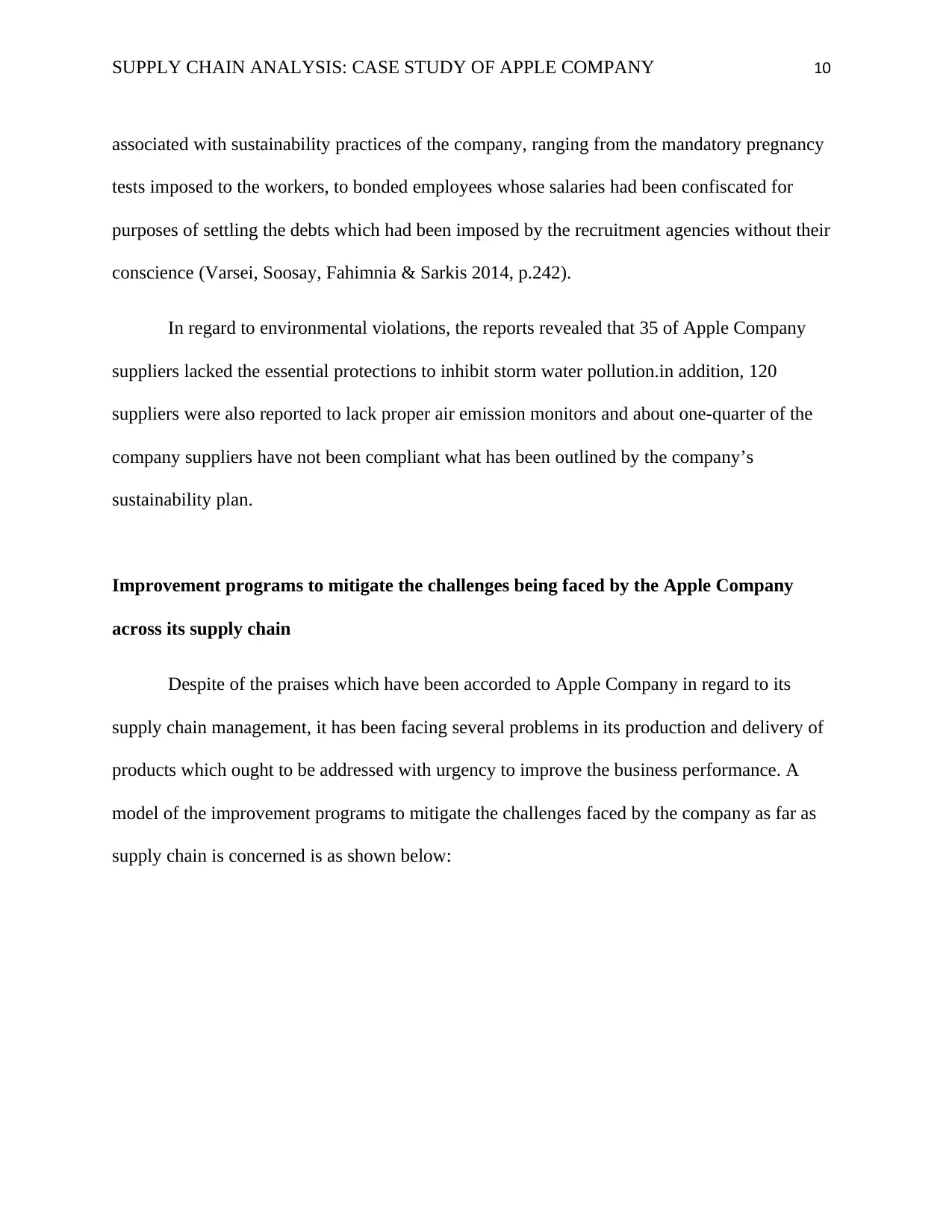
SUPPLY CHAIN ANALYSIS: CASE STUDY OF APPLE COMPANY 10
associated with sustainability practices of the company, ranging from the mandatory pregnancy
tests imposed to the workers, to bonded employees whose salaries had been confiscated for
purposes of settling the debts which had been imposed by the recruitment agencies without their
conscience (Varsei, Soosay, Fahimnia & Sarkis 2014, p.242).
In regard to environmental violations, the reports revealed that 35 of Apple Company
suppliers lacked the essential protections to inhibit storm water pollution.in addition, 120
suppliers were also reported to lack proper air emission monitors and about one-quarter of the
company suppliers have not been compliant what has been outlined by the company’s
sustainability plan.
Improvement programs to mitigate the challenges being faced by the Apple Company
across its supply chain
Despite of the praises which have been accorded to Apple Company in regard to its
supply chain management, it has been facing several problems in its production and delivery of
products which ought to be addressed with urgency to improve the business performance. A
model of the improvement programs to mitigate the challenges faced by the company as far as
supply chain is concerned is as shown below:
associated with sustainability practices of the company, ranging from the mandatory pregnancy
tests imposed to the workers, to bonded employees whose salaries had been confiscated for
purposes of settling the debts which had been imposed by the recruitment agencies without their
conscience (Varsei, Soosay, Fahimnia & Sarkis 2014, p.242).
In regard to environmental violations, the reports revealed that 35 of Apple Company
suppliers lacked the essential protections to inhibit storm water pollution.in addition, 120
suppliers were also reported to lack proper air emission monitors and about one-quarter of the
company suppliers have not been compliant what has been outlined by the company’s
sustainability plan.
Improvement programs to mitigate the challenges being faced by the Apple Company
across its supply chain
Despite of the praises which have been accorded to Apple Company in regard to its
supply chain management, it has been facing several problems in its production and delivery of
products which ought to be addressed with urgency to improve the business performance. A
model of the improvement programs to mitigate the challenges faced by the company as far as
supply chain is concerned is as shown below:
Paraphrase This Document
Need a fresh take? Get an instant paraphrase of this document with our AI Paraphraser
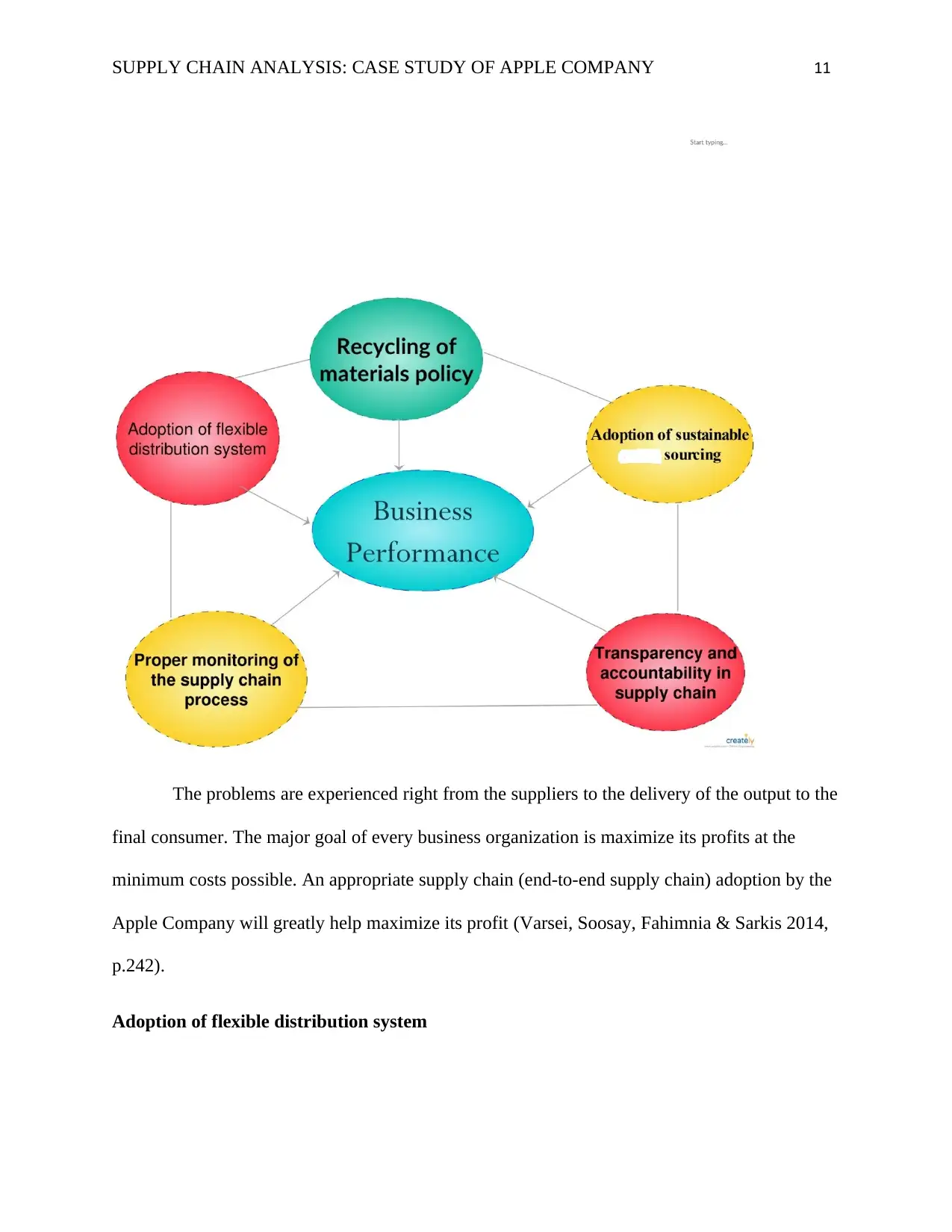
SUPPLY CHAIN ANALYSIS: CASE STUDY OF APPLE COMPANY 11
The problems are experienced right from the suppliers to the delivery of the output to the
final consumer. The major goal of every business organization is maximize its profits at the
minimum costs possible. An appropriate supply chain (end-to-end supply chain) adoption by the
Apple Company will greatly help maximize its profit (Varsei, Soosay, Fahimnia & Sarkis 2014,
p.242).
Adoption of flexible distribution system
The problems are experienced right from the suppliers to the delivery of the output to the
final consumer. The major goal of every business organization is maximize its profits at the
minimum costs possible. An appropriate supply chain (end-to-end supply chain) adoption by the
Apple Company will greatly help maximize its profit (Varsei, Soosay, Fahimnia & Sarkis 2014,
p.242).
Adoption of flexible distribution system
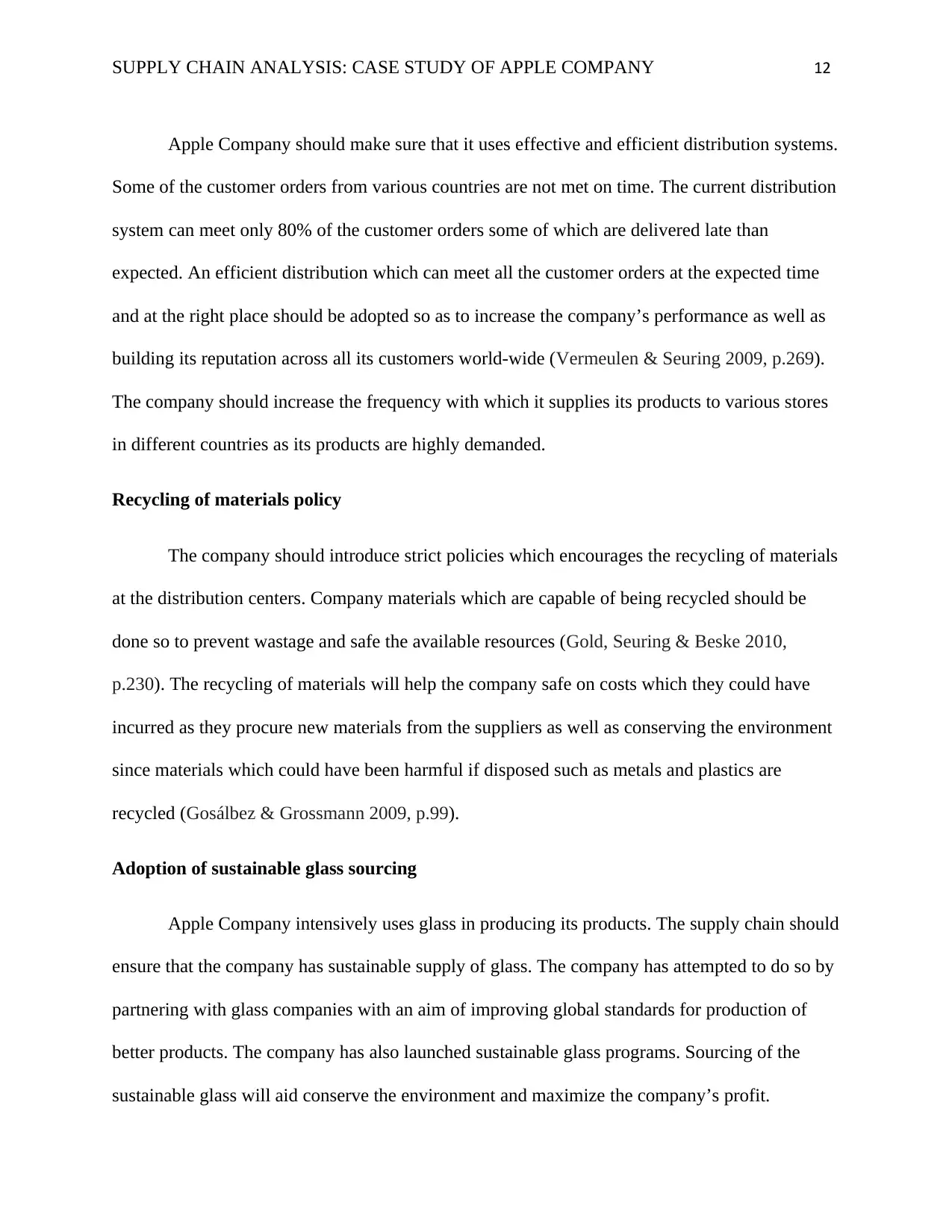
SUPPLY CHAIN ANALYSIS: CASE STUDY OF APPLE COMPANY 12
Apple Company should make sure that it uses effective and efficient distribution systems.
Some of the customer orders from various countries are not met on time. The current distribution
system can meet only 80% of the customer orders some of which are delivered late than
expected. An efficient distribution which can meet all the customer orders at the expected time
and at the right place should be adopted so as to increase the company’s performance as well as
building its reputation across all its customers world-wide (Vermeulen & Seuring 2009, p.269).
The company should increase the frequency with which it supplies its products to various stores
in different countries as its products are highly demanded.
Recycling of materials policy
The company should introduce strict policies which encourages the recycling of materials
at the distribution centers. Company materials which are capable of being recycled should be
done so to prevent wastage and safe the available resources (Gold, Seuring & Beske 2010,
p.230). The recycling of materials will help the company safe on costs which they could have
incurred as they procure new materials from the suppliers as well as conserving the environment
since materials which could have been harmful if disposed such as metals and plastics are
recycled (Gosálbez & Grossmann 2009, p.99).
Adoption of sustainable glass sourcing
Apple Company intensively uses glass in producing its products. The supply chain should
ensure that the company has sustainable supply of glass. The company has attempted to do so by
partnering with glass companies with an aim of improving global standards for production of
better products. The company has also launched sustainable glass programs. Sourcing of the
sustainable glass will aid conserve the environment and maximize the company’s profit.
Apple Company should make sure that it uses effective and efficient distribution systems.
Some of the customer orders from various countries are not met on time. The current distribution
system can meet only 80% of the customer orders some of which are delivered late than
expected. An efficient distribution which can meet all the customer orders at the expected time
and at the right place should be adopted so as to increase the company’s performance as well as
building its reputation across all its customers world-wide (Vermeulen & Seuring 2009, p.269).
The company should increase the frequency with which it supplies its products to various stores
in different countries as its products are highly demanded.
Recycling of materials policy
The company should introduce strict policies which encourages the recycling of materials
at the distribution centers. Company materials which are capable of being recycled should be
done so to prevent wastage and safe the available resources (Gold, Seuring & Beske 2010,
p.230). The recycling of materials will help the company safe on costs which they could have
incurred as they procure new materials from the suppliers as well as conserving the environment
since materials which could have been harmful if disposed such as metals and plastics are
recycled (Gosálbez & Grossmann 2009, p.99).
Adoption of sustainable glass sourcing
Apple Company intensively uses glass in producing its products. The supply chain should
ensure that the company has sustainable supply of glass. The company has attempted to do so by
partnering with glass companies with an aim of improving global standards for production of
better products. The company has also launched sustainable glass programs. Sourcing of the
sustainable glass will aid conserve the environment and maximize the company’s profit.
⊘ This is a preview!⊘
Do you want full access?
Subscribe today to unlock all pages.

Trusted by 1+ million students worldwide
1 out of 18
Related Documents
Your All-in-One AI-Powered Toolkit for Academic Success.
+13062052269
info@desklib.com
Available 24*7 on WhatsApp / Email
![[object Object]](/_next/static/media/star-bottom.7253800d.svg)
Unlock your academic potential
Copyright © 2020–2025 A2Z Services. All Rights Reserved. Developed and managed by ZUCOL.



